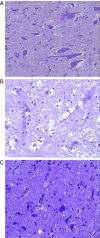Neuroprotective effect of curcumin on spinal cord in rabbit model with ischemia/reperfusion
- PMID: 23809530
- PMCID: PMC3595963
- DOI: 10.1179/2045772312Y.0000000028
Neuroprotective effect of curcumin on spinal cord in rabbit model with ischemia/reperfusion
Abstract
Background: Ischemic/reperfusion (I/R) injury of the spinal cord is a serious complication that can result from thoracoabdominal aortic surgery.
Objective: To investigate the neuroprotective effect of curcumin against I/R injury in a rabbit model.
Methods: A total of 36 rabbits were randomly divided into three groups: sham, I/R, and curcumin-treated group. Rabbits were subject to 30-min aortic occlusion to induce transient spinal cord ischemia. Neurological function was observed after reperfusion and spinal cord segment (L3-L5) was collected for histopathological evaluation. Malondialdehyde (MDA) and total superoxide dismutase (SOD) activity were also assayed.
Results: Rabbits in I/R group were induced to paraplegia. While after 48-hour treatment, compared with I/R group, curcumin significantly improved neurological function, reduced cell apoptosis and MDA levels as well as increased SOD activity (P < 0.05).
Conclusions: The results suggest that curcumin, at least in an animal model, can attenuate transient spinal cord ischemic injury potentially via reducing oxidative damage, which may provide a novel approach in the treatment of spinal cord ischemic injury.
Figures




References
-
- Ucak A, Onan B, Güler A, Sahin MA, Kılıçkaya O, Oztaş E, Uysal B, Arslan S, Yılmaz AT. Rosuvastatin, a new generation 3-hydroxy-3-methylglutaryl coenzyme a reductase inhibitor, reduces ischemia/reperfusion-induced spinal cord tissue injury in rats. Ann Vasc Surg 2011;25(2):686–95 - PubMed
-
- Herlambang B, Orihashi K, Mizukami T, Takahashi S, Uchida N, Hiyama E, Sueda T. New method for absolute spinal cord ischemia protection in rabbits. J Vasc Surg 2011;54(4):1109–16 - PubMed
-
- Wang JY, Shen J, Gao Q, Ye ZG, Yang SY, Liang HW, Bruce IC, Luo BY, Xia Q. Ischemic postconditioning protects against global cerebral ischemia/reperfusion-induced injury in rats. Stroke 2009;39(3):983–90 - PubMed
-
- Sun J, Yang D, Li S, Xu Z, Wang X, Bai C. Effects of curcumin or dexamethasone on lung ischaemia-reperfusion injury in rats. Eur Respir J 2009;3(2):398–404 - PubMed
Publication types
MeSH terms
Substances
LinkOut - more resources
Full Text Sources
Other Literature Sources
